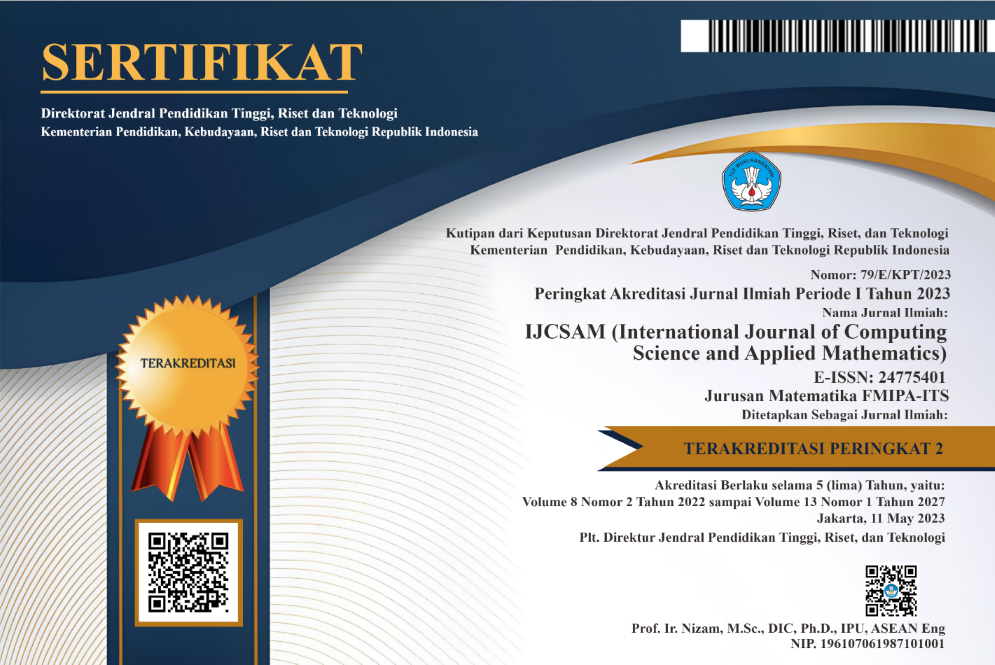Forecasting of Indonesian Crude Prices using ARIMA and Hybrid TSR-ARIMA
Abstract
Full Text:
PDFReferences
G. Zhang, “Time series forecasting using a hybrid arima and neural network model,” Neurocomputing, vol. 50, pp. 159–175, 2003.
S. Jere and E. Moyo, “Modeling epidemiological data using box-Jenkins procedure,” Open Journal of Statistics, vol. 6, pp. 295–302, 2016.
Shivani, K. Sandhu, and A. Nair, “A comparative study of arima and rnn for short term wind speed forecasting,” in in Proceedings of 10th International Conference on Computing, Communication and Networking Technologies (ICCCNT), (Kanpur, India), IEEE, 2019.
B. Siregar, E. Nababan, A. Yap, U. Andayani, and Fahmi, “Forecasting of raw material needed for plastic products based in income data using arima method,” in In Proceedings of 5th International Conference on Electrical, Electronics and Information Engineering (ICEEIE), IEEE, 2017.
A. Rahman and M. Hasan, “Modeling and forecasting of carbon dioxide emissions in bangladesh using autoregressive integrated moving average (arima) models,” Open Journal of Statistics, vol. 7, pp. 560–566, 2017.
M. Arumsari and A. Dani, “Peramalan data runtun waktu menggunakan model hybrid time series regression – autoregressive integrated moving average,” Jurnal Siger Matematika, vol. 2, no. 1, 2021.
K. Ramadani, S. Wahyuningsih, and M. Hayati, “Peramalan harga saham pt. telkom menggunakan model hybrid time series regression linier – autoregressive integrated moving average,” Jurnal Matematika, Statistika komputasi, vol. 18, no. 2, pp. 293–307, 2022.
S. Pradhina, E. Zukhronah, and Y. Susanti, “Perbandingan akurasi peramalan wisatawan mancanegara di provinsi bali menggunakan model hybrid time series regression-autoregressive integrated moving average dan model autoregressive integrated moving average,” Prosiding Pendidikan Matematika, Matematika dan Statistika, vol. 7, 2023.
W. Sulandari, Subanar, Suhartono, and H. Utami, “Forecasting electricity load demand using hybrid exponential smoothing-artificial neural network model,” International Journal of Advances in Intelligent Informatics, vol. 2, no. 3, pp. 131–139, 2016.
W. Sulandari, Subanar, Suhartono, H. Utami, and M. Lee, “Ssa-based hybrid forecasting models and applications,” Bulletin of Electrical Engineering and Informatics, vol. 9, no. 5, pp. 2178–2188, 2020.
I. Khandelwal, R. Adhikari, and G. Verma, “Time series forecasting using hybrid arima and ann models based on dwt decomposition,” Procedia Computer Science, vol. 48, pp. 173–179, 2015.
D. Suryani, M. Fadhilla, and A. Labellapansa, “Indonesian crude oil price (icp) prediction using multiple linear regression algorithm,” Jurnal RESTI (Rekayasa Sistem dan Teknologi Informasi), vol. 6, no. 6, pp. 1057–1063, 2022.
Sukono, E. Suryamah, and F. Novinta, “Application of arima issn: 2527-3426 -garch model for prediction of indonesian crude oil prices,”Operations Research: International Conference Series, vol. 1, no. 1, pp. 25–32, 2020.
W. Wei, “Time series analysis: Univariate and multivariate methods, 2nd ed.,” Pearson Education, Inc., 2006.
J. Hanke and D. Wichern, “Business forecasting, 9th ed,” Pearson Prentice Hall, 2009.
Z. Drezner, O. Turel, and D. Zerom, “A modified kolmogorov–Smirnov test for normality,” Communications in Statistics - Simulation and Computation, vol. 39, no. 4, pp. 693–704, 2010.
W. Enders, “Applied econometric time series, 3rd ed.,” John Wiley Sons, 2010.
G. Ljung and G. Box, “On a measure of lack of fit in time series models,” Biometrika, vol. 65, no. 2, pp. 297–303, 1978.
B. Bowerman and D. O’Connel, “Forecasting and time series: An applied approach, 3rd ed.,” Duxbury Press, 1993.
DOI: http://dx.doi.org/10.12962%2Fj24775401.v10i2.21946
Refbacks
- There are currently no refbacks.
View My Stats

International Journal of Computing Science and Applied Mathematics by Pusat Publikasi Ilmiah LPPM, Institut Teknologi Sepuluh Nopember is licensed under a Creative Commons Attribution-ShareAlike 4.0 International License.
Based on a work at https://iptek.its.ac.id/index.php/ijcsam.






